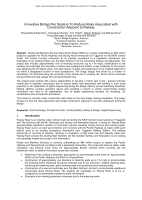Bridges

- Publication no: ABC2017-107-17
- Published: 26 April 2017
- PDF (free) Download
Roads and Maritime Services New South Wales (NSW) is currently undertaking an $84 million project to upgrade the Pacific Highway and Wyong Road Intersection at Tuggerah on the NSW Central Coast. The project involves conversion of an existing roundabout to a signalised intersection and duplication of an existing bridge over the Main Northern rail line connecting Sydney and Newcastle. The project also includes approximately 1km of retaining structures (up to 11m high), modifications to the existing rail overbridge and relocation of above and underground utilities. A key challenge for the project was designing the 45 degree skew, four span Super-T bridge and substructure to be installed adjacent to rail within a designated number of track possessions. The bridge design was driven by a number of constraints, the foremost being the proximity of the central pier to existing rail, direct current overhead wiring (OHW) and high voltage (HV) rail aerial feeder lines.
The project team worked with various stakeholders to develop a hybrid cast in-situ / precast concrete central pier to expedite construction and to reduce safety risks associated with working in such close proximity to rail. Application of digital engineering during the design delivery proved extremely beneficial, helping address complex geometry issues and providing a means to clearly communicate project constraints and risks to all stakeholders. Use of digital engineering included 3D modelling, 3D visualizations and construction animations.
The project is currently under construction with works on the new bridge nearing completion. This paper focuses on how the risks associated with bridge construction adjacent to rail were addressed during the design.
